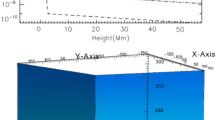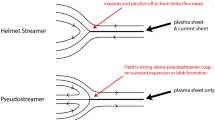Abstract
After obtaining the results published by Rouse (1986) of agreements of frequencies of oscillation in the five-minute band (5MB) with observations for nonradial l-degrees 0 to 19 and orders n ≦ 20 or so, a sensitivity study was performed that demonstrates that calculating the sequences of observed frequencies throughout the 5MB is dependent on the mesh spacing used in the eigenvalue calculations as well as on the radial position of the outer boundary. It is shown that relative to the reference mesh used in the high-Z core (HZC) model 5A calculations of Rouse (1986), changes in the mesh spacing produce nonlinear changes in the 5MB frequencies as a function of order n for fixed degree l, with higher n-orders like 24 or more being changed much more than lower n-orders like 12. Regions with rapid variations in γ e turn out to be the indicator of where the space steps for oscillation eigenvalues should be decreased.
In the l = 2, nonradial results with the Cowling approximation (CA) obtained to date, one space mesh used with model 5A of Rouse (1985) yields the best agreement with the published Duvall and Harvey (1983) l = 3 observations, differing by 4.5 μHz or less. On the other hand, four other meshes used with same model 5A yield excellent agreement with the observed nearly constant frequency spacing for orders n = 18 to 22, but each displaced by a nearly constant 8 to 11 μHz to lower frequencies.
Comparisons with 5MB frequencies from a recalculated standard solar model using the author's program show large deviations from published frequencies of oscillation calculated by others using conventional standard models, as well as large deviations from the frequencies of oscillation from the HZC model. The effects of the relatively large mesh spacings used in conventional standard models are discussed. It is concluded that in order to accurately calculate the sequences of 5MB frequencies, the space steps used in solar model calculations must be of magnitude Δx ≦ 10−3, and the space steps used in the oscillation eigenvalue calculations must be of magnitude Δx ≦ 5.0 × 10−3. It is also concluded that the conventional standard model practice of using P = KT 5/2 to establish the outer convective zone and the model radius precludes the possibility of calculating the nearly constant period spacing and, hence, of using the 5MB frequencies as an accurate diagnostic of the interior structure of the Sun and of solar-type stars.
The frequencies of the radial mode of oscillation from both the HZC model and the recalculated standard model were calculated with the radial differential equation that neglects the gravitational perturbation (the Cowling approximation) (Smeyers, 1984) and with the radial differential equation that includes the gravitational perturbation (Ledoux and Walraven, 1958). The results are compared, with sensitivities to the mesh spacings and the gravitational perturbation discussed.
Similar content being viewed by others
References
Bahcall, J. N., Huebner, W. F., Lubow, S. H., Parker, P. D., and Ulrich, R. K.: 1982, Rev. Mod. Phys. 54, 767.
Duvall, T. L., Jr and Harvey, J. W.: 1983, Nature 302, 24.
Hill, H. A.: 1985, Astrophys. J. 290, 765.
Ledoux, P and Walraven, T.: 1958, Handbuch d. Physik. 51, 353.
Noels, A., Scuflaire, R., and Gabriel, M.: 1984, Astron. Astrophys. 130, 389.
Rouse, C.A.: 1964, Calculation of Stellar Structure Using an Ionization Equilibrium Equation of State, Univ. of Calif., UCRL Report 7820-T, dated April 1964. Published as part of Rouse (1968).
Rouse, C. A.: 1967, J. Math. Phys. 46, 63.
Rouse, C. A.: 1968, in C. A. Rouse (ed.), Progress in High Temperature Physics and Chemistry, Pergamon Press, Oxford, Vol. 2, p. 97.
Rouse, C. A.: 1971, in C. A. Rouse (ed.), Progress in High Temperature Physics and Chemistry, Pergamon Press, Oxford, Vol. 4, p. 139.
Rouse, C. A.: 1977, Astron. Astrophys. 55, 5477.
Rouse, C. A.: 1979, Astron. Astrophys. 71, 95.
Rouse, C. A.: 1981, Astron. Astrophys. 102, 8.
Rouse, C. A.: 1983, Astron. Astrophys. 126, 102.
Rouse, C. A.: 1985, Astron. Astrophys. 149, 65 (Paper I).
Rouse, C. A.: 1986, Solar Phys. 106, 205(this issue) (Paper II).
Scuflaire, R.: 1974, Astron. Astrophys. 36, 107.
Sears, R. L.: 1964, Astrophys. J. 140, 477.
Smeyers, P.: 1984, in A. Noels and M. Gabriel (eds.) ‘Nonradial Oscillations of Stars’, Theoretical Problems in Stellar Stability and Oscillations, Proceedings of the 25th Liège International Astrophysical Colloquium, July 10–13, 1984, p. 1.
Ulrich, R. K. and Rhodes, E. J.: 1983, Astrophys. J. 265, 551.
Woodard, M. and Hudson, H. S.: 1983, Nature 305, 589.
Author information
Authors and Affiliations
Rights and permissions
About this article
Cite this article
Rouse, C.A. Evidence for a small, high-Z, iron-like solar core. Sol Phys 106, 217–235 (1986). https://doi.org/10.1007/BF00158493
Received:
Revised:
Issue Date:
DOI: https://doi.org/10.1007/BF00158493




